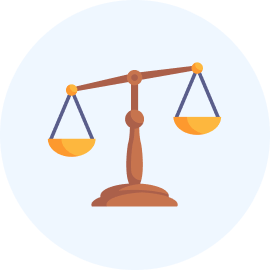CLAT Exam > CLAT Questions > What is one primary reason President Droupadi...
Start Learning for Free
What is one primary reason President Droupadi Murmu cited for the need to reduce delays in the judicial system?
- a)To ensure timely access to justice for economically disadvantaged individuals
- b)To increase the number of judges in the High Courts
- c)To enhance the complexity of court procedures
- d)To promote the use of technology in courts
Correct answer is option 'A'. Can you explain this answer?
| FREE This question is part of | Download PDF Attempt this Test |
Verified Answer
What is one primary reason President Droupadi Murmu cited for the need...
President Droupadi Murmu emphasized that delays in the court system create significant challenges for poor and rural individuals seeking justice. These delays contribute to a sense of uncertainty, particularly for those already facing barriers in the legal system due to their economic or geographic circumstances. By reducing these delays, the aim is to make justice more accessible and timely for vulnerable communities. Additionally, ensuring access to justice is a fundamental aspect of upholding the rule of law in any society.

|
Explore Courses for CLAT exam
|

|
Similar CLAT Doubts
What is one primary reason President Droupadi Murmu cited for the need to reduce delays in the judicial system?a)To ensure timely access to justice for economically disadvantaged individualsb)To increase the number of judges in the High Courtsc)To enhance the complexity of court proceduresd)To promote the use of technology in courtsCorrect answer is option 'A'. Can you explain this answer?
Question Description
What is one primary reason President Droupadi Murmu cited for the need to reduce delays in the judicial system?a)To ensure timely access to justice for economically disadvantaged individualsb)To increase the number of judges in the High Courtsc)To enhance the complexity of court proceduresd)To promote the use of technology in courtsCorrect answer is option 'A'. Can you explain this answer? for CLAT 2025 is part of CLAT preparation. The Question and answers have been prepared according to the CLAT exam syllabus. Information about What is one primary reason President Droupadi Murmu cited for the need to reduce delays in the judicial system?a)To ensure timely access to justice for economically disadvantaged individualsb)To increase the number of judges in the High Courtsc)To enhance the complexity of court proceduresd)To promote the use of technology in courtsCorrect answer is option 'A'. Can you explain this answer? covers all topics & solutions for CLAT 2025 Exam. Find important definitions, questions, meanings, examples, exercises and tests below for What is one primary reason President Droupadi Murmu cited for the need to reduce delays in the judicial system?a)To ensure timely access to justice for economically disadvantaged individualsb)To increase the number of judges in the High Courtsc)To enhance the complexity of court proceduresd)To promote the use of technology in courtsCorrect answer is option 'A'. Can you explain this answer?.
What is one primary reason President Droupadi Murmu cited for the need to reduce delays in the judicial system?a)To ensure timely access to justice for economically disadvantaged individualsb)To increase the number of judges in the High Courtsc)To enhance the complexity of court proceduresd)To promote the use of technology in courtsCorrect answer is option 'A'. Can you explain this answer? for CLAT 2025 is part of CLAT preparation. The Question and answers have been prepared according to the CLAT exam syllabus. Information about What is one primary reason President Droupadi Murmu cited for the need to reduce delays in the judicial system?a)To ensure timely access to justice for economically disadvantaged individualsb)To increase the number of judges in the High Courtsc)To enhance the complexity of court proceduresd)To promote the use of technology in courtsCorrect answer is option 'A'. Can you explain this answer? covers all topics & solutions for CLAT 2025 Exam. Find important definitions, questions, meanings, examples, exercises and tests below for What is one primary reason President Droupadi Murmu cited for the need to reduce delays in the judicial system?a)To ensure timely access to justice for economically disadvantaged individualsb)To increase the number of judges in the High Courtsc)To enhance the complexity of court proceduresd)To promote the use of technology in courtsCorrect answer is option 'A'. Can you explain this answer?.
Solutions for What is one primary reason President Droupadi Murmu cited for the need to reduce delays in the judicial system?a)To ensure timely access to justice for economically disadvantaged individualsb)To increase the number of judges in the High Courtsc)To enhance the complexity of court proceduresd)To promote the use of technology in courtsCorrect answer is option 'A'. Can you explain this answer? in English & in Hindi are available as part of our courses for CLAT.
Download more important topics, notes, lectures and mock test series for CLAT Exam by signing up for free.
Here you can find the meaning of What is one primary reason President Droupadi Murmu cited for the need to reduce delays in the judicial system?a)To ensure timely access to justice for economically disadvantaged individualsb)To increase the number of judges in the High Courtsc)To enhance the complexity of court proceduresd)To promote the use of technology in courtsCorrect answer is option 'A'. Can you explain this answer? defined & explained in the simplest way possible. Besides giving the explanation of
What is one primary reason President Droupadi Murmu cited for the need to reduce delays in the judicial system?a)To ensure timely access to justice for economically disadvantaged individualsb)To increase the number of judges in the High Courtsc)To enhance the complexity of court proceduresd)To promote the use of technology in courtsCorrect answer is option 'A'. Can you explain this answer?, a detailed solution for What is one primary reason President Droupadi Murmu cited for the need to reduce delays in the judicial system?a)To ensure timely access to justice for economically disadvantaged individualsb)To increase the number of judges in the High Courtsc)To enhance the complexity of court proceduresd)To promote the use of technology in courtsCorrect answer is option 'A'. Can you explain this answer? has been provided alongside types of What is one primary reason President Droupadi Murmu cited for the need to reduce delays in the judicial system?a)To ensure timely access to justice for economically disadvantaged individualsb)To increase the number of judges in the High Courtsc)To enhance the complexity of court proceduresd)To promote the use of technology in courtsCorrect answer is option 'A'. Can you explain this answer? theory, EduRev gives you an
ample number of questions to practice What is one primary reason President Droupadi Murmu cited for the need to reduce delays in the judicial system?a)To ensure timely access to justice for economically disadvantaged individualsb)To increase the number of judges in the High Courtsc)To enhance the complexity of court proceduresd)To promote the use of technology in courtsCorrect answer is option 'A'. Can you explain this answer? tests, examples and also practice CLAT tests.

|
Explore Courses for CLAT exam
|

|
Suggested Free Tests
Signup for Free!
Signup to see your scores go up within 7 days! Learn & Practice with 1000+ FREE Notes, Videos & Tests.























